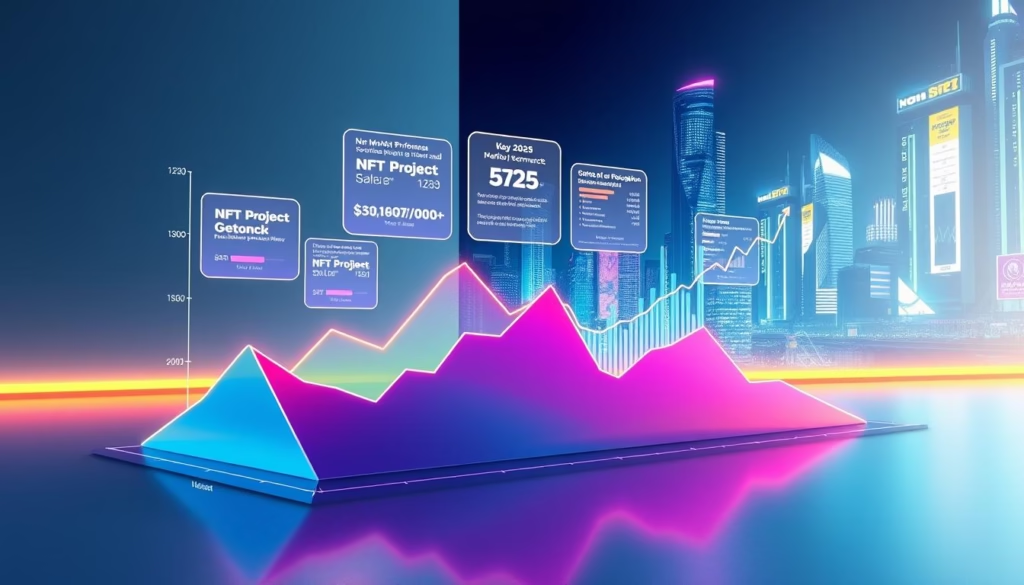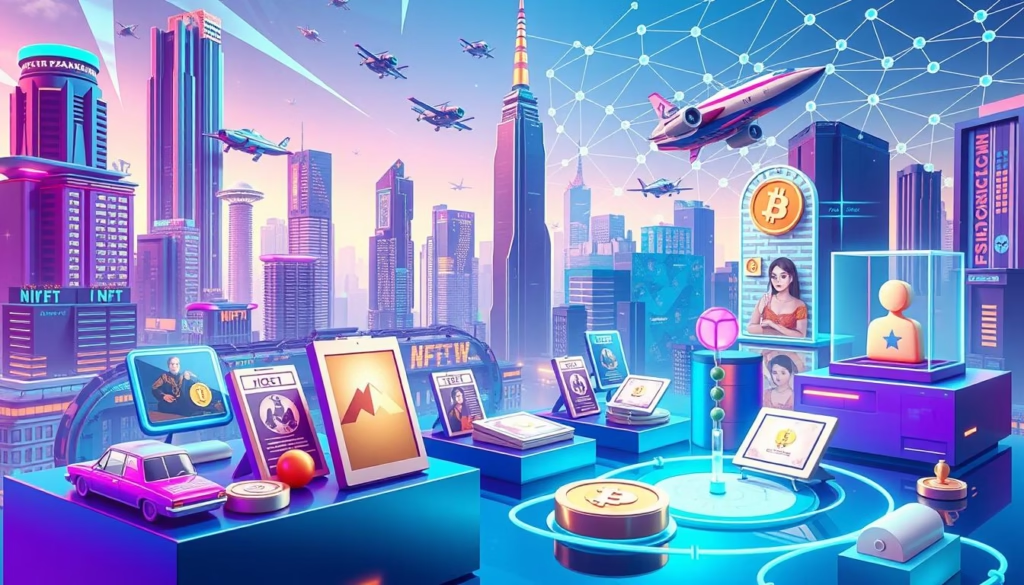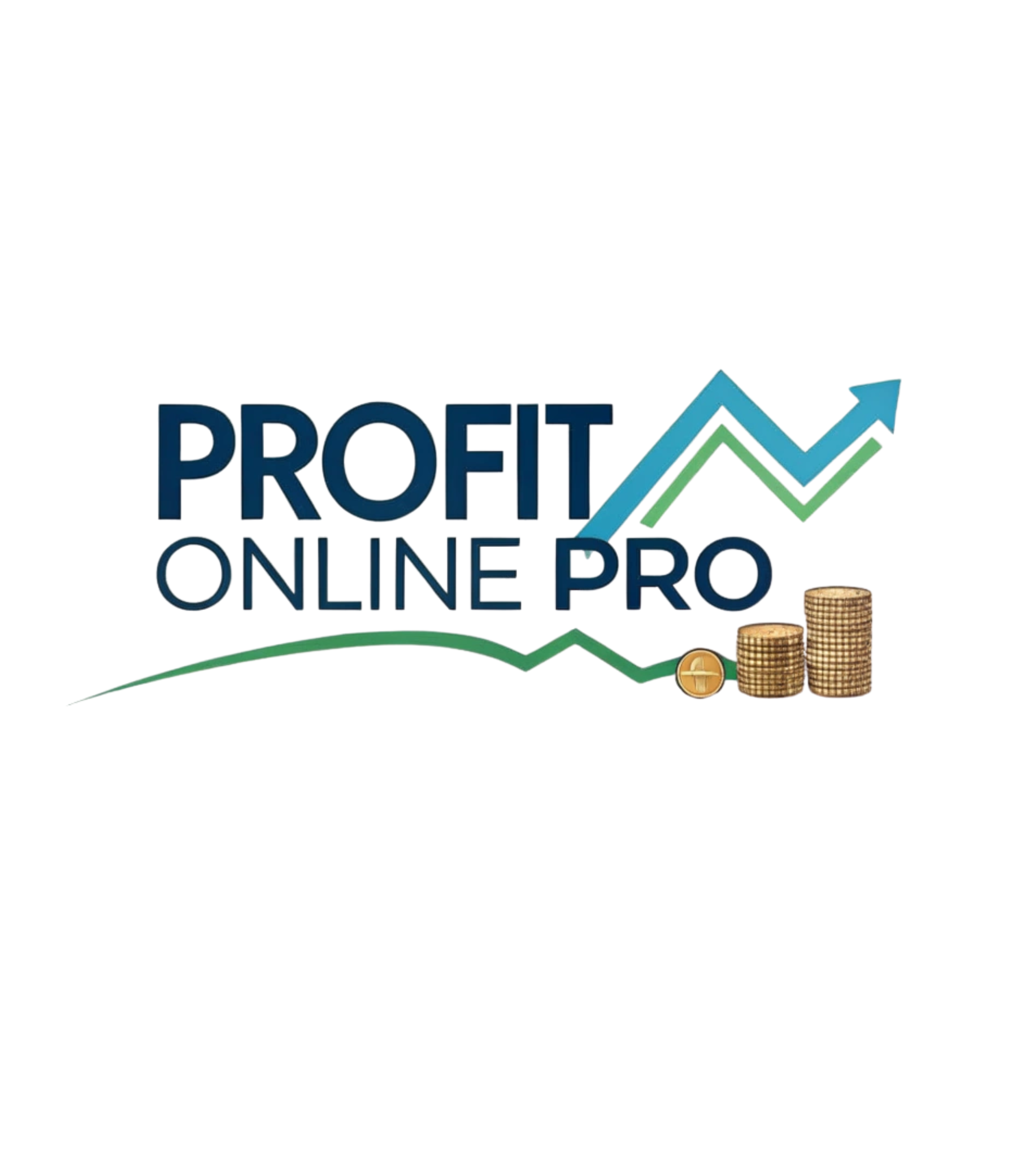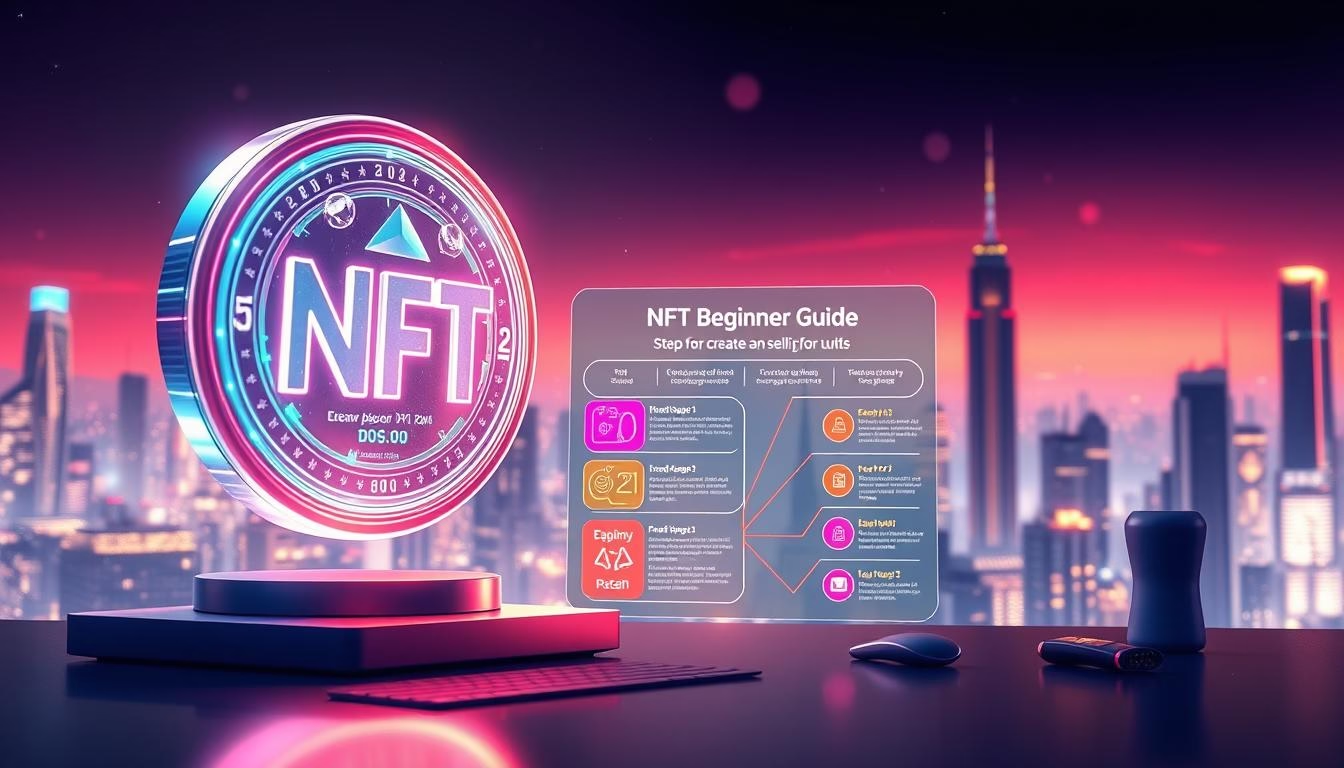NFTs, or Non-Fungible Tokens, are a big deal in the digital world heading into 2025. They are unique digital items that show you own something special, like art or music.
These items live on a blockchain, which makes them rare and real. You can find NFTs in digital art, music, and even virtual places.
More and more people want to learn about NFTs. This guide will show you how to make and sell NFTs in 2025.
Key Takeaways
- NFTs represent unique digital assets that signify ownership.
- They are stored on a blockchain, ensuring scarcity and authenticity.
- NFTs have various use cases, including digital art and music.
- The popularity of NFTs continues to grow in 2025.
- Understanding NFTs is crucial for navigating the digital landscape.
The State of NFTs in2025
As we enter 2025, the NFT market is growing fast. It has changed a lot since 2021, with new trends and chances appearing.
Evolution of the NFT Market Since 2021
The NFT market has grown a lot since 2021. At first, it was all about digital art and collectibles. Now, it includes music, real estate, and virtual goods too.
Key milestones include:
- The rise of NFT marketplaces like OpenSea and Rarible
- Increased adoption by mainstream brands and artists
- Advancements in blockchain technology, improving scalability and reducing costs
Now, NFTs focus more on usefulness. They offer special benefits and experiences to their holders.
Current Trends and Opportunities
In 2025, the NFT market is full of exciting trends. One big trend is combining NFTs with VR and AR. This creates amazing, immersive experiences for users.
| Trend | Description | Opportunity |
|---|---|---|
| NFTs in Gaming | Integration of NFTs into gaming ecosystems, enabling true ownership of in-game assets. | New revenue streams for game developers and players. |
| Virtual Real Estate | NFTs representing ownership of virtual land and properties. | Investment opportunities and creation of virtual experiences. |
| Digital Identity | Use of NFTs for verifying identity and credentials online. | Enhanced security and privacy for users. |

These trends show a diverse and growing NFT market. There are many chances for creators, investors, and users to explore this technology.
Understanding NFTs: The Basics
NFTs have changed the digital world, offering a new way to create, buy, and sell unique digital assets. At their core, NFTs, or Non-Fungible Tokens, represent ownership of a specific item. This can be a piece of art, a collectible, or even music.
What Are NFTs and How Do They Work?
NFTs are built on blockchain technology, ensuring their uniqueness and scarcity. Unlike cryptocurrencies, NFTs are non-fungible, meaning they can’t be exchanged for another identical asset. Each NFT has a distinct identity and value, making them perfect for unique digital assets.
The process of creating an NFT involves minting it on a blockchain. This securely records its ownership and provenance.
Key characteristics of NFTs include:
- Uniqueness: Each NFT is distinct and cannot be replicated.
- Ownership: NFTs provide a secure way to prove ownership of a digital asset.
- Transferability: NFTs can be bought, sold, and traded on various online marketplaces.
Popular Use Cases for NFTs in 2025
NFTs have a wide range of applications across different industries. Some of the most popular use cases include:
Digital Art and Collectibles
NFTs have become a popular medium for digital artists to showcase and sell their work. They provide a way to prove ownership and scarcity, making digital art more valuable.
Music and Entertainment NFTs
Musicians and entertainers are using NFTs to release exclusive content. This includes limited-edition albums or behind-the-scenes footage. This new model allows artists to connect directly with their fans and monetize their work in innovative ways.
Access Passes and Utility NFTs
Beyond art and collectibles, NFTs are being used as access passes or utility tokens. For example, an NFT can grant access to exclusive events or provide special privileges within a community.

Essential Tools and Requirements for Creating NFTs
Starting your NFT journey means knowing what tools and money you need. You’ll need the right computer, software, and funds to begin.
Hardware and Software Needs
You’ll need a good computer for NFT creation. It should have a strong processor and enough storage. For making and editing digital items, you’ll need software like Adobe Photoshop and Illustrator.
Digital Wallets and Cryptocurrency Basics
A digital wallet is key for handling cryptocurrencies. MetaMask is a top pick for NFT creators because it works well with many marketplaces. It’s important to know the basics of cryptocurrency, like how to buy and keep it safe.
Budget Considerations for Beginners
Starting out, you might not need to spend a lot. But, the cost can go up if your NFT project gets complex. You’ll face expenses like gas fees for minting, marketplace fees, and possibly design software or professional services.
It’s wise to plan your budget well to move smoothly through the NFT world.
How to Create and Sell NFTs in2025: Step-by-Step Process
Creating and selling NFTs in 2025 is easy with the right steps. From starting your idea to listing it online, there are key steps to follow. Knowing these steps is vital for anyone wanting to create NFTs in 2025 and sell NFTs online.
Planning Your NFT Project
First, plan your NFT project well. Choose a concept, theme, or subject for your NFT. Think about what digital assets you want to make—like art, music, or other media. Defining your project’s scope and objectives will guide your decisions.
Also, research your target audience and see what NFTs are popular now. This is key to making sure your NFT has buyers when you’re ready to sell.
Creating Digital Assets for NFTs
Next, create the digital assets for your NFTs. This could be designing art, composing music, or making other digital content. The quality and uniqueness of your assets will affect their value in the NFT market.
When making digital assets, think about the technical needs of the marketplaces you’ll use. Knowing the best file formats and sizes can make your NFTs more appealing.
Preparing Metadata and Properties
After your assets are ready, prepare the metadata and properties for your NFTs. Metadata includes the NFT’s name, description, and any extra attributes that add value. Good metadata helps your NFTs show up on marketplaces.
Properties might include rarity, edition number, or special features that make your NFT unique. Crafting this information well will make your NFTs more appealing and valuable. As you get ready to minting NFTs, having accurate metadata will make the process smoother.
Designing Your NFT Artwork
To stand out in the crowded NFT market, your artwork needs to be both visually stunning and technically sound. The design of your NFT is crucial as it directly impacts its appeal to potential buyers.
Using Canva for NFT Design
Canva is a user-friendly graphic design tool that is ideal for beginners creating NFTs. It offers a wide range of templates and design elements that can be customized to fit your NFT’s theme. Canva’s drag-and-drop interface makes it easy to experiment with different layouts and designs.
To create an NFT using Canva, start by selecting a template or designing from scratch. Ensure your design meets the recommended dimensions for NFT marketplaces, typically 1:1 ratio and at least 1000 x 1000 pixels.
Creating Professional NFTs with Photoshop
For more advanced NFT creators, Adobe Photoshop offers powerful tools for crafting professional-grade digital art. With Photoshop, you can achieve intricate details and complex compositions that can elevate your NFT’s value.
When using Photoshop for NFT design, consider utilizing layers to organize your work and make adjustments. Exporting your artwork in the correct format is also crucial; most NFT marketplaces support PNG, JPEG, and GIF files.
Other Design Tools and Resources
Beyond Canva and Photoshop, there are numerous other tools and resources available for NFT design. These include online graphic editors like Pixlr and GIMP, as well as 3D modeling software such as Blender.
- Pixlr: A free online photo editor with advanced features.
- GIMP: A free and open-source raster graphics editor.
- Blender: A free 3D creation software that supports modeling, rigging, animation, rendering, and more.
Design Tips for Marketable NFTs
Creating marketable NFTs involves more than just technical proficiency; it requires an understanding of what appeals to collectors and buyers. Here are some key design tips:
- Keep it simple and focused.
- Use vibrant colors and unique compositions.
- Ensure your NFT is visually consistent with your brand or collection theme.
By following these guidelines and leveraging the right design tools, you can create NFTs that not only showcase your artistic talent but also resonate with the NFT community.
Choosing the Right Blockchain for Your NFTs
Choosing the right blockchain for your NFTs is key to your project’s success. The blockchain you pick will impact your transaction costs, speed, and security.
Ethereum: The Pioneer Blockchain
Ethereum is a top choice for NFTs, with many tools and a big developer community. It supports the ERC-721 standard, a common choice for NFTs. But, Ethereum’s high gas fees can be a problem, especially when the network is busy.
Polygon: Low-Cost Alternative
Polygon (formerly Matic Network) is a layer 2 solution. It has lower gas fees and faster transactions than Ethereum. It’s great for creators who want to save money without losing security.
Solana: Fast and Efficient
Solana is known for its quick transactions and low fees. It uses proof-of-stake and is scalable. This makes it good for big NFT projects.
Comparing Gas Fees and Transaction Speeds
When picking a blockchain, look at gas fees and transaction speeds. Here’s a comparison of Ethereum, Polygon, and Solana:
| Blockchain | Average Gas Fee | Transaction Speed |
|---|---|---|
| Ethereum | $5-$50 | 15-30 seconds |
| Polygon | $0.01-$1 | 2-5 seconds |
| Solana | $0.0001-$0.1 | 0.4-1 second |
In conclusion, the right blockchain for your NFTs depends on your project’s needs. Look at your budget, desired speed, and security needs. Knowing the pros and cons of Ethereum, Polygon, and Solana will help you choose wisely for your NFT project’s success.
Setting Up Your Crypto Wallet
Setting up a crypto wallet is key to your NFT journey. It lets you store, send, and receive digital assets safely. A crypto wallet connects you to the blockchain, making it easy to use NFT marketplaces and manage your assets.
MetaMask Setup Guide
MetaMask is a top choice for NFT transactions. Start by installing the browser extension or mobile app. Then, create a new wallet and securely store your seed phrase.
This seed phrase is vital for recovering your wallet. So, keep it safe and private.
After setting up MetaMask, add funds by transferring cryptocurrency. MetaMask supports Ethereum and other networks, making it versatile for NFT transactions.
Alternative Wallet Options
MetaMask isn’t the only option. Trust Wallet, Coinbase Wallet, and WalletConnect are alternatives. Trust Wallet, for example, supports many cryptocurrencies and is easy to use.
When picking an alternative wallet, think about security, ease of use, and compatibility with NFT marketplaces.
Securing Your Wallet and Assets
Securing your crypto wallet and assets is crucial. Enable two-factor authentication (2FA) and keep your wallet software updated. Avoid phishing scams and never share your seed phrase or private keys.
Using a hardware wallet can add extra security, especially for large assets. Regular backups and staying informed about security best practices will protect your digital assets.
Minting and Listing Your NFTs on Marketplaces
To turn your digital art into NFTs, you need to understand the minting process on platforms like OpenSea and Rarible. Minting is the process of creating a unique digital asset on a blockchain. This makes it possible to buy, sell, and trade.
OpenSea: The Largest NFT Marketplace
OpenSea is the largest NFT marketplace, offering a vast array of digital assets. To mint NFTs on OpenSea, you need to connect your digital wallet. Then, follow the platform’s straightforward minting process. OpenSea supports various file types, making it versatile for creators.
Rarible: Community-Owned Platform
Rarible is a community-owned NFT marketplace that allows creators to mint and sell NFTs with ease. It features a user-friendly interface and supports multiple blockchain networks. This provides flexibility for artists.
Zora: Creator-Focused Marketplace
Zora is a creator-focused marketplace that empowers artists by offering tools to mint and manage their NFTs effectively. It emphasizes community engagement and provides a seamless minting experience.
Step-by-Step Minting Process
The process of minting NFTs involves several key steps:
- Preparing your digital artwork
- Setting up your NFT’s metadata
- Finalizing the minting transaction on your chosen marketplace
Uploading Your Artwork
Begin by uploading your digital artwork to the marketplace. Ensure that your file is in a supported format and meets the platform’s guidelines.
After uploading, you’ll need to set properties for your NFT. This includes its name, description, and royalties. Royalties allow you to earn a percentage of sales whenever your NFT is resold.
Finalizing the Minting Transaction
Once your NFT is configured, you’ll need to confirm the minting transaction using your digital wallet. This step involves paying a gas fee, which varies depending on the blockchain network.
By following these steps, you can successfully mint and list your NFTs on popular marketplaces. This makes your digital creations available to a global audience.
Marketing and Selling Your NFTs Successfully
To do well in the NFT market, creators need good marketing plans. They also need to build a strong community around their digital items.
Building a Community on Twitter/X
Twitter/X is great for NFT creators to meet potential buyers and fans. Start by posting interesting content about your NFT project. Use hashtags to get more people to see your posts. Also, talk about popular NFT topics to get noticed.
Tip: Always talk back to your followers. This builds a loyal group that supports your NFT work.
Leveraging Discord for NFT Projects
Discord is a top choice for NFT communities. It’s where creators share updates, talk to their audience, and grow a loyal group. Make a special server for your NFT project. Share behind-the-scenes stuff, sneak peeks, and special news there.
Strategy: Use Discord’s roles to offer different levels of involvement. Reward your most active members.
Instagram Strategies for NFT Artists
Instagram is perfect for NFT artists to show off their work. Post high-quality images or videos of your digital art. Use Instagram Stories and Reels to share how you create.
Tip: Talk back to your followers. Use Instagram’s features like polls and quizzes to get people involved.
Pricing Strategies and Collection Building
Setting the right price for your NFTs is key to getting buyers. Look at what similar NFTs are selling for. Think about how unique and rare your digital items are when setting prices.
Setting the Right Price Point
To find the right price, look at sales data from similar NFT projects. Consider the cost of making your work, how much people want it, and what your competitors charge.
Creating Cohesive Collections
Having a cohesive collection makes your NFTs more valuable. Make sure your NFTs have a consistent theme, style, or story. This makes your collection more appealing to buyers.
| Pricing Strategy | Description | Benefits |
|---|---|---|
| Fixed Pricing | Setting a fixed price for your NFTs based on their perceived value. | Easy to understand, straightforward for buyers. |
| Dynamic Pricing | Adjusting the price based on demand, scarcity, or other market factors. | Allows for flexibility, can maximize profits. |
| Auctions | Selling NFTs through an auction process, where the highest bidder wins. | Can drive up prices, creates excitement around NFTs. |
Avoiding Scams and Maximizing Profits
Exploring NFTs in 2025 is exciting, but beware of pitfalls. The NFT world offers chances but also challenges. Creators and buyers must stay alert.
Common NFT Scams and How to Avoid Them
Scams in the NFT market include fake sites, phishing, and fake NFTs. To stay safe, check if the NFT and marketplace are real. Look for reviews and use trusted platforms. Be careful with offers that ask for your private info.
Watch out for fake NFT giveaways that ask for your crypto or wallet details. Never give out your private keys or seed phrases.
Understanding Gas Fees and Minimizing Costs
Gas fees are the cost of doing business on blockchain. To save money, learn about gas fees and how to cut costs. Choosing the right blockchain, like Polygon or Solana, can lower fees.
Transact when the network is less busy to save on fees. Also, use layer 2 solutions to cut costs further.
Setting Up Royalties for Passive Income
Setting NFT royalties lets creators earn from NFT sales. Most platforms, like OpenSea and Rarible, support this. When you mint your NFT, set a royalty rate for each sale.
To boost your earnings, create valuable NFTs. A strong brand and community can also increase your NFT’s value and royalties.
Conclusion: Turning Your Creativity into Web3 Income
Creating and selling NFTs can be very profitable for artists and musicians. By learning about NFTs and using the right tools, you can make money online. This guide has shown you how to do it.
The NFT market is always changing, offering new ways to make money. Whether you’re into art, music, or other digital content, success comes from staying updated. This way, you can keep up with new trends and ideas.
By following this guide, you’re ready to make money from your creativity in the web3 world. As the NFT market grows, so will the chances for creators. Now is a great time to start your nft business and see where it takes you.




